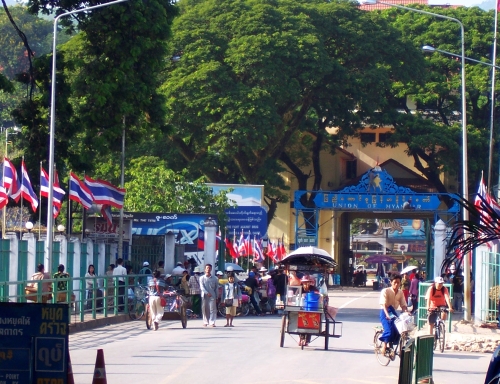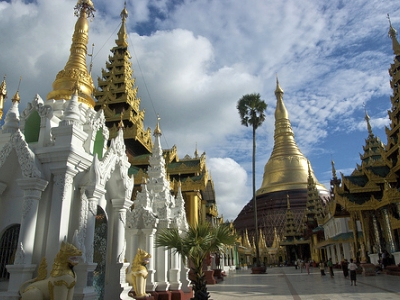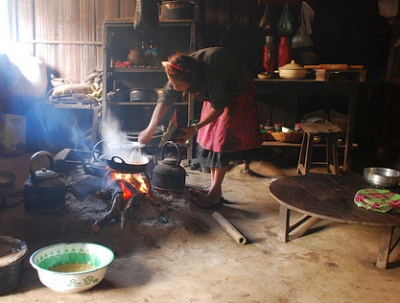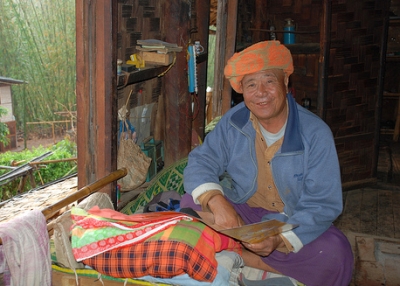The post And You Thought Myanmar Couldn’t Get Much Better Looking [Video] appeared first on The Expeditioner Travel Site.
]]>This stunner featuring Myanmar (Burma) comes to us from Singaporean student Kevin Ng Jia Quan, who trekked to the Southeast Asian country with his Canon 5D Mark III (and 24-105mm lens) in tow, along with his Glidecam HD2000 for all those pretty Steadicam-like shots.
For more great travel videos like these, visit our Travel Video group at Vimeo.
By Matt Stabile

ABOUT THE AUTHOR
 Matt Stabile is the founder and Editor-in-Chief of TheExpeditioner.com. You can read his writings, watch his travel videos, purchase the book he co-edited or contact him via email at any time at TheExpeditioner.com. (@TheExpeditioner)
Matt Stabile is the founder and Editor-in-Chief of TheExpeditioner.com. You can read his writings, watch his travel videos, purchase the book he co-edited or contact him via email at any time at TheExpeditioner.com. (@TheExpeditioner)
The post And You Thought Myanmar Couldn’t Get Much Better Looking [Video] appeared first on The Expeditioner Travel Site.
]]>The post See The Colors Of Myanmar Shining Through [Travel Video] appeared first on The Expeditioner Travel Site.
]]>Marcin Kepka, from our Travel Videos group on Vimeo, recently shared this video from his 3-week trip to Myanmar (Burma), shot with his Canon 7D and GoPRO HD Hero, and brimming with enough colors and luscious shots of homemade food to make you start exploring tickets there to check it out yourself.
[Myanmar by Marcin Kepka/Vimeo]
The post See The Colors Of Myanmar Shining Through [Travel Video] appeared first on The Expeditioner Travel Site.
]]>The post The Easiest Way To Get A Myanmar Visa appeared first on The Expeditioner Travel Site.
]]>
With considerable political reforms occurring over the last year, Myanmar (Burma), once a pariah state in the world of travel, has become this year’s hottest backpacker destination. Although some significant human rights issues remain, travelers are keen to experience the legendary, relatively “untouched” culture of this unique Southeast Asian country, hot on the heels of several Western world leaders who have recently made the trip.
However, there are several challenges that must be faced before one can pack up and head into the unknown. The first is obtaining a visa, which remains a tiring and time-consuming process, with one exception: the Myanmar Embassy in Bangkok, Thailand. In Bangkok it is possible to get a visa in a matter of days, without the unexplained delays and the need for invitations, itineraries, business contacts, etc . . . , that travellers have reported facing at other embassies.
Although heading to Bangkok may seem a little extreme just to get a visa , keep in mind that since overland travel into the country is still not a viable option, Bangkok is without a doubt the cheapest entry point to Myanmar, with flights to the former capital, Yangon, from as little as $80.
The Embassy in Bangkok is located at 132 Sathorn Nua Rd, Silom. Applications are only accepted in the morning, from 9 a.m. until 12 p.m., Monday to Friday. Of course, the Embassy is closed on both Thailand’s and Myanmar’s public holidays.
By far the easiest option for getting to the Embassy is the BTS Skytrain. The Embassy is located just 200-300 meters from Surasak Station. At Surasak Station, take EXIT 3, turn right at the bottom of the stairs and follow the direction of the traffic down the Sathorn Nua Rd. You will walk past several large schools, and then come to the Embassy’s prison-like walls on your left. While it may be tempting to skip the BTS and take a taxi from your hotel, Bangkok’s notoriously bad traffic makes this a far less desirable option than it initially may seem.
If you are coming from the Khaosan Road area (Banglamphu), there is unfortunately no nearby BTS station. Perhaps the nicest way to get there is via the river from Phra Arthit Pier (N13). From here take the “orange flag” Express Boat to Sathorn Pier (Central Pier). Tickets cost a mere 15B, and the ride takes a pleasant half hour or so. From Sathorn Pier you can transfer to the BTS at Saphan Taksin Station, just one stop from Surasak .
Once you arrive at the Embassy, you will need:
- 2 passport photos
- Visa application form (available at the Embassy)
- A photocopy of the photo page of your passport
- For the express 1-day visa service you will also need your flight tickets/itinerary
- A good book (waiting times can be long!)
Fortunately, for the disorganized traveler, an enterprising Thai couple has established a business just a few minutes walk past the entrance to the Embassy, providing passport photos, photocopies, paperclips and glue, all at a bargain price!
There are three price options available for visas: to pick up the same day costs 1260B, the next working day 1035B, and in two working days it costs 810B. These prices are standard regardless of your nationality. Passports can only be picked up between 3:30 p.m. and 4:30 p.m. on your selected day.
Once you have picked up your visa, the first of your challenges is over. Now you just need to find enough clean, crisp U.S. dollar bills to fund your entire trip, as there are still not many reliable ATMs in the entire country . . .
(Please note, this information is all accurate as of August 2012. The process, times and prices may change at any point!)
By Evan Ritli
[Border Crossing by Ryan Harvey/Flickr]

About the Author
Evan Ritli is a frequent traveller and occasional writer from Melbourne, Australia. Usually writing on politics and International Relations, Evan was formerly an editor for the Australian Institute of International Affair’s webzine, Monthly Access. More recently he has been working as a policy manager for Left Right Think Tank. He can be contacted at evanritli@gmail.com.
The post The Easiest Way To Get A Myanmar Visa appeared first on The Expeditioner Travel Site.
]]>The post Get To Burma By 2013 Or Don’t Bother Going At All? appeared first on The Expeditioner Travel Site.
]]>
There is a predictable pattern for the emergence of new travel hot spots around the world. First, that country must be mired in civil war or be under the thumb of an oppressive dictatorship that frowns upon outsiders entering their country (which has the perverse effect of staving off over-development and preserving culture at the expense of personal freedom and safety).
Then, as the regime falls or war wanes, said country begins the first tentative steps into normalization, with a trickle of adventurous travelers and a gaggle of eager travel writers visiting the country, amazed by the lack of infiltration by the tourism masses, yet keenly aware that this is likely short-lived.
Then comes the onslaught of visitors who make it a point to get there themselves after hearing one too many stories of how great the country is and how few tourists are there, and who arrive somewhat aghast at the number of other travelers there doing the same.
Then, finally, tour companies, luxury resorts, flash-sale websites and retirees enter the fray, firmly establishing the destination as a true “vacation” spot.
The list is seemingly endless, but a few off the top of my head are: Vietnam, Thailand, Costa Rica, Colombia, Argentina, China and Indonesia; all of which have spent time in various parts of this cycle during the last 40 years.
And you can now add Burma to that list. As Burma’s once repressive regime opens up, travelers are beginning to stream into what was once the last holdout in Southeast Asia to foreign visitors.
Just this week, friend of The Expeditioner David Farley filed this article with the San Francisco Chronicle detailing his time spent in Burma last year. His reason to get there so soon? As he points out, the time is now to avoid the crowd: “I wanted to see it before the crush of tourism changes the face of the country. After all, a million tourists are expected to visit in 2012 — up 300 percent from last year.”
And when should one get to Burma to visit U Bein’s Bridge, the longest teak span in the world; trek into the Shan Hills to experience rural life with the locals; or see Inle Lake with its floating pagodas and lakeside villages? Per David:
[Matt], a Burma travel veteran and tour guide for Intrepid Travel, was there to scout out new itineraries for the tour operator. Intrepid, hopeful about the changes, had just reinstituted its Burma tours after a decadelong absence because of Suu Kyi’s call for a boycott on tourism in Burma.
Now, he told me, many of Intrepid’s organized tours in Burma for 2012 were already sold out or selling at a brisk pace. “If you’d been here a year ago, as I was, and come back now,” Matt said, “you’d be amazed at the changes that have taken place. It’s going to change even more in the next year.” Matt went on to say that anyone who wants to see the pre-tourist-explosion Burma should go by 2013 at the latest.
You’ve been warned.
[Experience newly open Burma before the crush]
[Praying Couple by Roger Price/Flickr]
The post Get To Burma By 2013 Or Don’t Bother Going At All? appeared first on The Expeditioner Travel Site.
]]>The post Is The Time To Visit Burma Now? appeared first on The Expeditioner Travel Site.
]]>
With the end of Secretary of State Clinton’s historic visit to Myanmar (Burma) wrapping up last week — the first of any high-ranking official from the U.S. in 50 years — it’s safe to assume that a good portion of the millions of eyes that watched as Clinton toured Shwedegon Pagoda in Yangon (barefoot no less) are contemplating trips themselves to the secretive nation.
It’s a great thought. As travelers to Southeast Asia know, it’s not exactly an untrodden path anymore along those hostel hotspots of Phuket, Bangkok, Siem Riep, Saigon, Luang Prabang and Hanoi. But with negative news coverage, tricky land crossings, and a limitation on visas to those who work in “sensitive” industries, Burma is still virgin land for most travelers.
The State Department notes that if you plan on heading there, be aware that the authorities “have often prohibited entry or exit at most land border crossings, unless the traveler is part of a package-tour group that has received prior permission from the Burmese authorities,” and that visas need to be obtained ahead of time. Oh yeah, there have also been reports of journalists being kicked out or harassed while visiting. (Does this include friendly bloggers?)
But if you do decide to go, you’re in luck. As the FT notes, parts of the fabled city of Rangoon (now Yangon) “are like vast film sets, with not just dozens of early 20th century buildings but entire streets undisturbed by modern construction . . . a legacy of the country’s isolation and lack of development for so many years.”
A walk along Maha Bandula Square takes you to the high court with its famous clock tower and Queene Anne architecture, and nearby is the Shwedagon Pagoda complex that Ms. Clinton herself toured. And if there is any question as to the city’s influence during its height, along Pansodan Street are the art deco homes of the HSBC, Lloyds, Grindleys, the Indian Reserve Bank and the Chartered Bank.
And when you get back, look upon that passport stamp fondly. You may have successfully beaten the crowds.
[Forgotten Treasures/Financial Times]
[Around Shwedagon Pagoda by Jason Tabarias/Flickr]
The post Is The Time To Visit Burma Now? appeared first on The Expeditioner Travel Site.
]]>The post Should You Travel To Burma? An Ethical Debate appeared first on The Expeditioner Travel Site.
]]>
A recent article has brought up a question that most seasoned travelers end up asking themselves: Is travel sometimes bad?
Some may say that it drives the economy in countries or cities that have seen their resources depleted, no longer able to provide for the ever-increasing mouths, bodies and minds to feed. Some people believe that tourism provides a sharing of experiences not only by learning from the host culture but exposing a traveler’s ideals as well.
However, there are also some who believe tourism can have a negative impact on the host culture’s infrastructure. With tourism comes gentrification of industry which means that McDonald’s, Starbucks, Wal-Mart, Best Western and Hilton begin to overtake local businesses. With tourism, especially in developing countries, the sex trade increases along with other introductory perversions to an established culture.
In the case of Burma, some suggest — like the above article — that travelers are discouraged from visiting the country in order to prevent more money falling into the hands of a corrupt government/dictatorship. The problem is, who really suffers?
As the article points out, the locals suffer because many rely on outsiders for money for living — food, water, shelter, and education.
Herein lies the proverbial Chinese finger puzzle: If you travel to Burma, a couple of families will get to have these basic essentials in the short term while, simultaneously, the dictatorship is perpetuated with every dollar spent on traveling around the country.
However, I would like to argue that, much like the puzzle, one shouldn’t pull too hard on either direction. In general, people should try to avoid, to the best of their abilities, making purchases at big-box stores or staying in multinational hotel chains.
Of course there are some luxuries that are only provided for by multinational corporations (MNC’s), but as a traveler, it is our obligation to be aware of our impact, not only on a monetary level, but on a cultural level as well. If you have the choice between a processed burger from the King or a homemade sandwich from a local vendor, in the unforgettable words of the knight in “The Last Crusade,” choose wisely.
Personally, as a traveler who will continue to travel, I think tourism can have a positive impact if each person is more conscious of his or her influence on the cultural environment he or she visits. It doesn’t have to be an ethical tug-of-war. Perhaps, if enlightened tourists flocked to Burma, the existing corruption would gain further exposure, thus, creating international pressure to address some fundamental political rights. It could loosen the tension between “want” and “ought” and, like the Chinese finger puzzle, the dilemma might slip right off.
By Brit Weaver

About the Author

Toronto born and based, Brit is an avid leisure cyclist, coffee drinker and under-a-tree park-ist. She often finds herself meandering foreign cities looking for street eats to nibble, trees to climb, a patch of grass to sit on, or a small bookstore to sift through. You can find her musing life on her personal blog, TheBubblesAreDead.wordpress.com.
The post Should You Travel To Burma? An Ethical Debate appeared first on The Expeditioner Travel Site.
]]>The post Trekking Burma appeared first on The Expeditioner Travel Site.
]]>
Follow Christina on her 62-kilometer trek through the hills of central Myanmar, the country formerly known as Burma.
By Christina Koukkos
The bus from Yangon (also known as Rangoon) crawled away in a swirl of dust and exhaust, leaving Marjan and me standing alone and delirious from lack of sleep on a dark street at 3 a.m. The bus had delivered us to Kalaw, a popular trekking base in Myanmar, three hours early. After just two days, the country was already living up to its oft-repeated comparison with George Orwell’s “1984.” In Myanmar, up is down. Left could be left, or it could be right — the steering wheels of local vehicles, we had noticed, might be on side one or the other. And now the most outrageous evidence so far: a public bus that arrived three hours ahead of schedule.
Marjan, my travel companion, held the flashlight as I squinted at the map in our guide book and led us the few blocks to the Golden Lilly Guest House. Beyond our most immediate need of a place to sleep, our plan was to hire Lilly’s brother Robin, a well-regarded local guide, for a three-day, 62-kilometer trek through the hills from Kalaw to the western shore of Inle Lake. Besides the physical challenge, lovely vistas and chance to interact with local villagers, the trek promised a respite from the tension and paranoia (real or imagined) that we were constantly being monitored by a government suspicious of independent travelers. More practically, the trek promised a transportation option that did not feature the organ-jarring discomforts of bus travel.
Sitting on the western edge of the Shan plateau in central Myanmar, relatively cool at an elevation of 1,320 meters, Kalaw is ideally situated for one-, two- or three-day treks. Many of the surrounding villages are peopled by so-called hill tribes: the 150 semi-nomadic, ethnically distinct clans who settled in northern Thailand, Laos and Myanmar from Nepal, Mongolia and China around the 19th century. Deliberately self-isolated, they form nominally self-sufficient communities that maintain their own language and customs. In Myanmar, they also bear the brunt of the malicious and arbitrary persecution typical of the government — jailed or executed without cause, used as slave labor for municipal building projects, and sometimes forced to move their entire village with just a few days’ notice.
A few mornings later, Robin led us out of Kalaw, setting a brisk pace westward into the hills. We were scheduled to cover 18 of the 62 kilometers that day. Our daypacks carried only essentials: change of clothes, umbrella, rain poncho, camera and toothbrush. Lilly had arranged to deliver our larger backpacks to a guest house in Nyaung Shwe, the village on Inle Lake where we would arrive, theoretically, in three days.
Robin’s height, ragged cotton trousers, not to mention his Sikh turban and beard, seemed out of place in a country peopled with slight, clean-shaven men wearing sarong-like longyis. His grandfather had been stationed in the area with the British army during World War II. Like many other Indian and Nepalese former soldiers, he decided to stay on after Burma achieved independence in 1948.
Robin grew up in Kalaw. These hills, he told us, were once swathed in humid jungles teeming with tigers, elephants and wild pigs. When he was a child, his father wouldn’t let him out to play, for fear that the tigers would get him. Now he leads tourists across the same hills, by now denuded by foreign logging companies who paid off the Burmese military junta. This strip mining, coupled with the local practice of slash-and-burn land clearing, has transformed the hills into farmland that supports crops such as corn, soybeans and tea.
About three hours after leaving Kalaw we arrived at the Viewpoint, an aptly named hilltop guest house and “resting place.” The proprietor, a Kalaw native of Nepalese descent, served us green tea and papaya as we sprawled out under the thatch-roofed gazebo. His daughter quickly went to work cooking us sweet potato curry for “lunch” (it was only 10:30 am).
 After lunch we continued at a remarkably fast pace, periodically stopping in villages to meet locals, sip tea in their homes, and — frankly — catch our breath. Like a page out of a fairy tale, the homes we visited were made either of bamboo, wood or brick, depending on the family’s wealth. Some even boasted glass windows. The floors were covered with bamboo mats that could be positioned around a low wooden table during meal times or spaced around the room at night for sleeping. The only adornments were a Buddhist shrine in the corner and, inexplicably, wall calendars, often a few years old and featuring what seemed to be heavily made-up Myanmar celebrity couples.
After lunch we continued at a remarkably fast pace, periodically stopping in villages to meet locals, sip tea in their homes, and — frankly — catch our breath. Like a page out of a fairy tale, the homes we visited were made either of bamboo, wood or brick, depending on the family’s wealth. Some even boasted glass windows. The floors were covered with bamboo mats that could be positioned around a low wooden table during meal times or spaced around the room at night for sleeping. The only adornments were a Buddhist shrine in the corner and, inexplicably, wall calendars, often a few years old and featuring what seemed to be heavily made-up Myanmar celebrity couples.
By mid-afternoon we arrived in the Palaung village that would serve as our stop for the night. The village chief, whose house we would sleep in, greeted us upon our arrival. His wife escorted us into their home, served us tea and papaya, then left us to rest until dinner. In bed by sundown, we woke up just after sunrise to the patter of rain against the windows. The Buddhist monastery where we would spend the second night was 26 kilometers away, an achievable challenge under normal circumstances. However, both Marjan and I were stricken by diarrhea, and the continuous rain had transformed the hard clay earth into goopy, slippery mud that stuck like concrete blocks to our Tevas as we walked. (As it turns out, the unseasonable rain was the edge of Typhoon Nargis. But that’s a story for another time.)
 With me sweating under my plastic poncho and Marjan carrying an umbrella in one hand and a roll of toilet paper in the other, we slogged through the mud and rain, crossing rice paddies and ravines, following cow paths through fields and scaling steep, rocky slopes. The second day was not about beautiful landscapes or getting educated about the flora and fauna, it was about surviving. Just past noon and just before a torrential downpour, we slid into Konla, a Danu tribe village, for lunch. Our host was a jolly, wrinkled man wearing the traditional Danu orange headdress, orange flannel shirt and purple longyi. As we sipped tea and rested, he sat by an open window, gazing thoughtfully at the intensifying rain.
With me sweating under my plastic poncho and Marjan carrying an umbrella in one hand and a roll of toilet paper in the other, we slogged through the mud and rain, crossing rice paddies and ravines, following cow paths through fields and scaling steep, rocky slopes. The second day was not about beautiful landscapes or getting educated about the flora and fauna, it was about surviving. Just past noon and just before a torrential downpour, we slid into Konla, a Danu tribe village, for lunch. Our host was a jolly, wrinkled man wearing the traditional Danu orange headdress, orange flannel shirt and purple longyi. As we sipped tea and rested, he sat by an open window, gazing thoughtfully at the intensifying rain.
After lunch we waited as long as we dared for the rain to abate and then set off again, leaving just enough time for us to straggle in to the monastery, dripping wet and sheathed in mud, just before nightfall. The simple teakwood structure, its ornate metal roof streaked with rust, sat on a small hill between a scrap of jungle and a series of Danu villages. We cleaned ourselves up as best we could before our audience with the solemn and friendly head monk. We wanted to make a donation, since the local villages depend upon the monastery to help pay for school supplies, health care and other necessities.
We awoke before dawn to the chants of novice monks. The rain had abated overnight, easing our trek for the last 18 kilometers. As we crested our last hill, the sun broke through the clouds and sparkled against Inle Lake, a few kilometers below us. We smiled and slid our way into the convoy of villagers carrying produce and traditional textiles to the markets along the lake.
A few hours later we arrived in Nyaung Shwe, filthy, drained and delighted that we had survived the first of many tests of our fortitude in Myanmar.

The post Trekking Burma appeared first on The Expeditioner Travel Site.
]]>